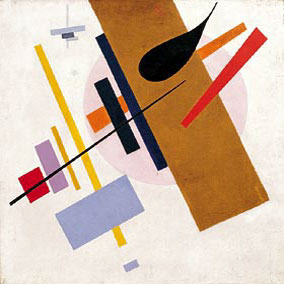 |
 |
|||
 |
Kazimir Malevich has long been celebrated as one of the seminal founders of non-objective art in the 20th century. Between 1915 and 1932, he developed a system of abstract painting he called Suprematism, an art of pure form meant to be universally comprehensible regardless of cultural origins. With his innovative oeuvre, Malevich intended to create an artistic utopia that would evoke higher states of spiritual consciousness and become the secular equivalent of religious painting. Kazimir Malevich: Suprematism is the first exhibition to focus exclusively on this defining moment in the artist's career, bringing together 100 paintings, drawings, and objects drawn from public and private collections around the world. Included are works that have never been shown in the West before, as well as several recently rediscovered masterpieces. The exhibition opens with Malevich's Alogisms, works composed of signs, symbols, and word fragments that form a bridge between his prior Cubist phase and the breakthrough to non-objective art. That watershed occurred in 1915, when he painted a black square on a white field, setting in motion a series of artworks that became the focal point for the Russian avant-garde. This exhibition marks the first time that the original version of Black Square has traveled outside of Russia, and the first time since 1920 it has been seen alongside the related works Black Cross, Black Circle, and Elongated Plane (all 1915). By 1916, Suprematism had already shifted from an aesthetic of static composition into a dynamic realm, exemplifying the artist's desire to render visually different states of feeling. The next year, he returned to a simple vocabulary less anchored in concrete form—the works are ethereal and seem to dissolve into imaginary space. Soon after, Malevich began experimenting with Suprematism as a means for social transformation, in plaster studies he called Architektons. By the late 1920s, Malevich folded Suprematism into an investigation of the figure, before completely abandoning it in 1932 for an art steeped in Renaissance portraiture. The exhibition closes with a small group of these Suprematist figures, the studies for which definitively link them to the abstract system of the preceding 15 years. —Susan Braeuer Curated by Matthew Drutt, Chief Curator of the Menil Collection, Kazimir Malevich: Suprematism is accompanied by a fully-illustrated catalogue. The book features previously unpublished letters and essays of the artist, as well as essays by Drutt and other Malevich experts. It is available at www.guggenheimstore.org or (800) 329-6109. Plane in Rotation, Called Black Circle, 1915. Oil on canvas, 31 1/8 x 31 1/8 inches. Private collection, courtesy Galerie Gmurzynska, Zug. Suprematism (Supremus no. 55), 1916. Oil on canvas, 31 1/2 x 31 1/2 inches. Regional Art Museum F.A. Kovalenko, Krasnodar. |